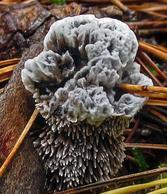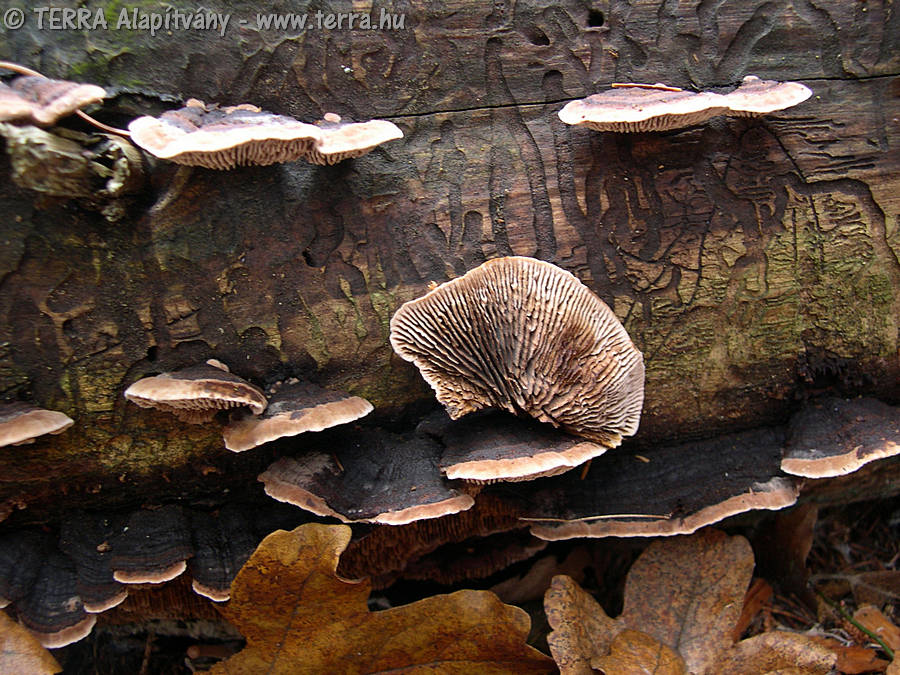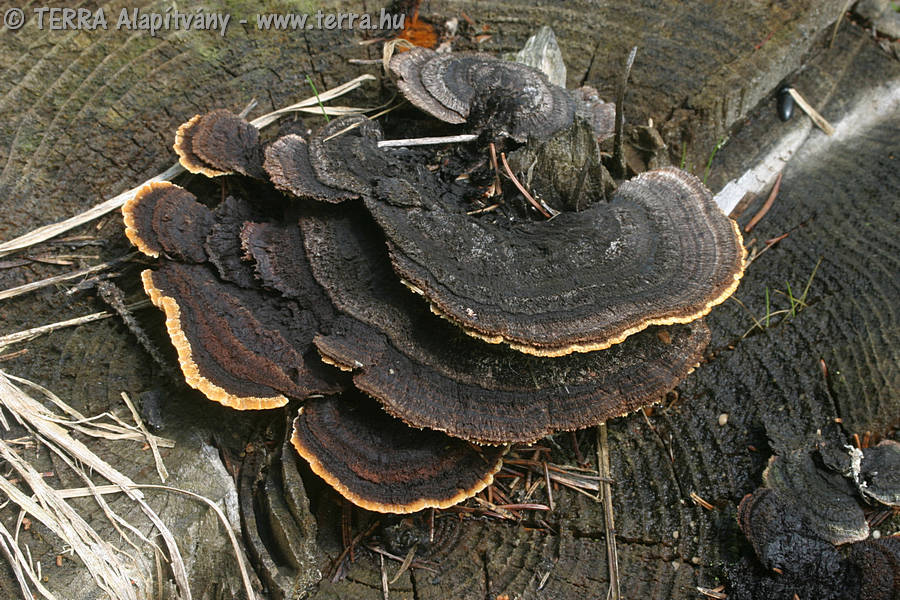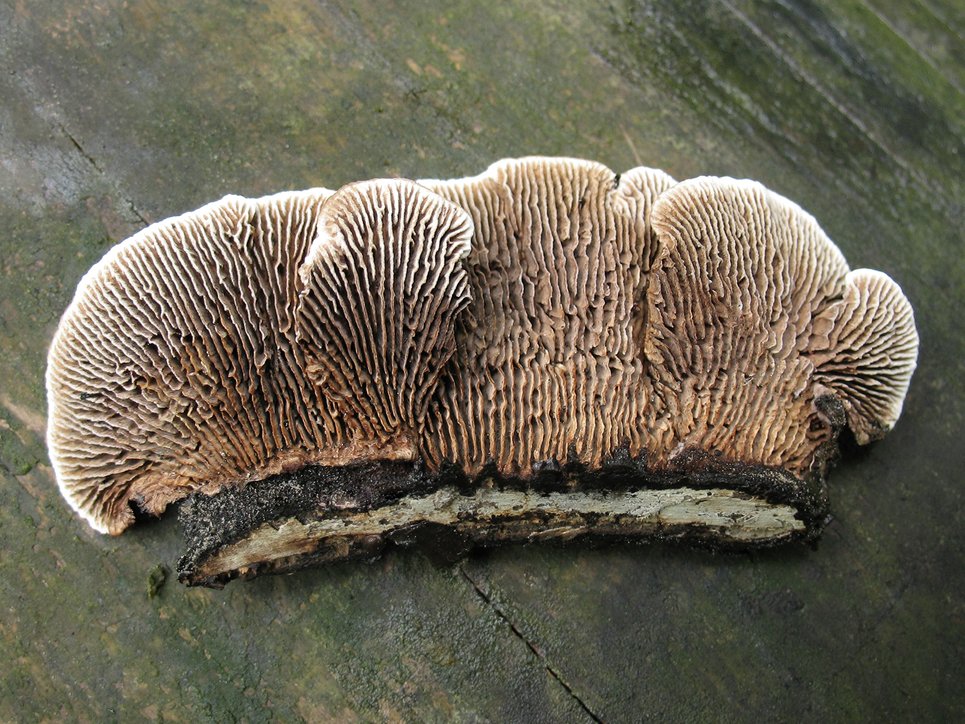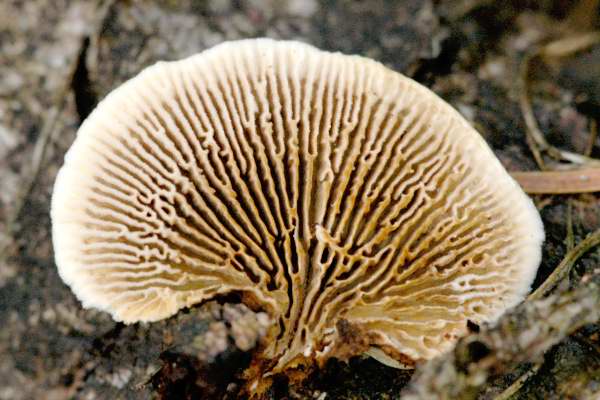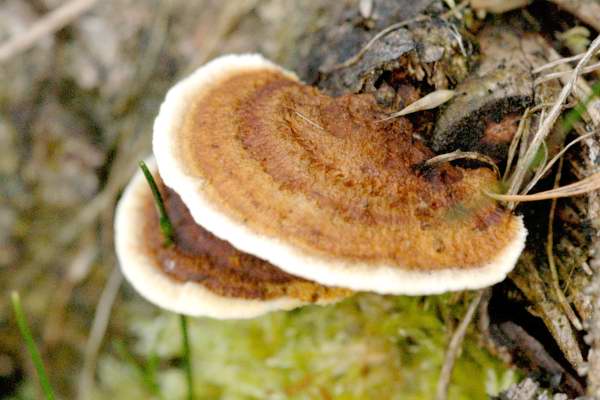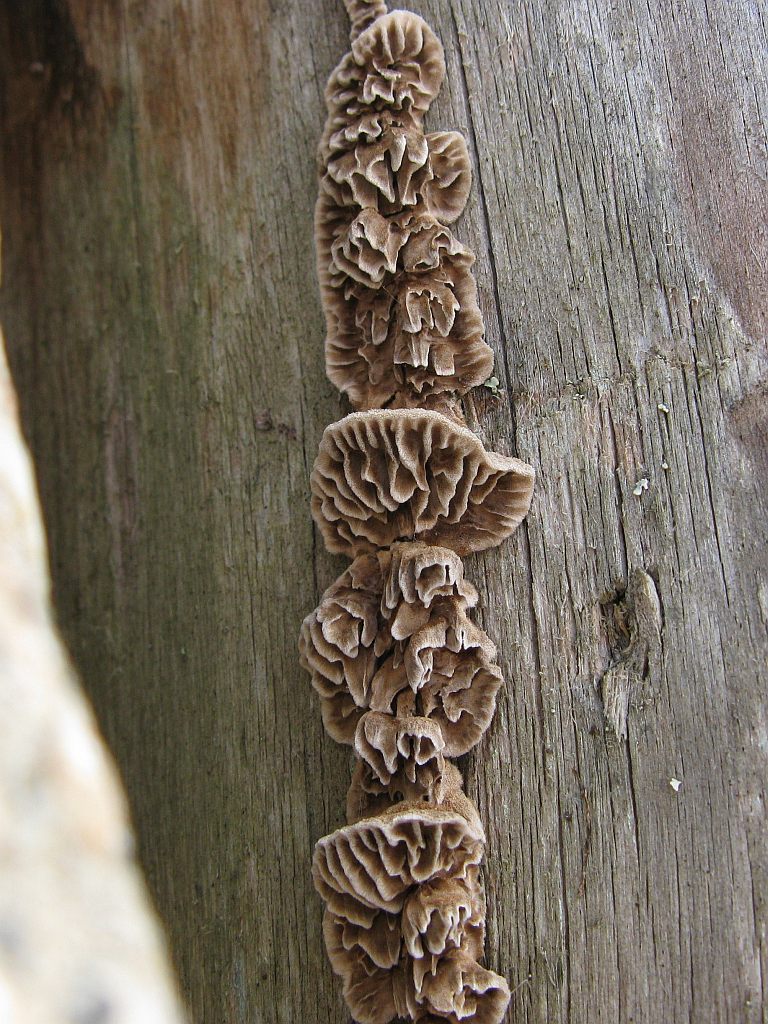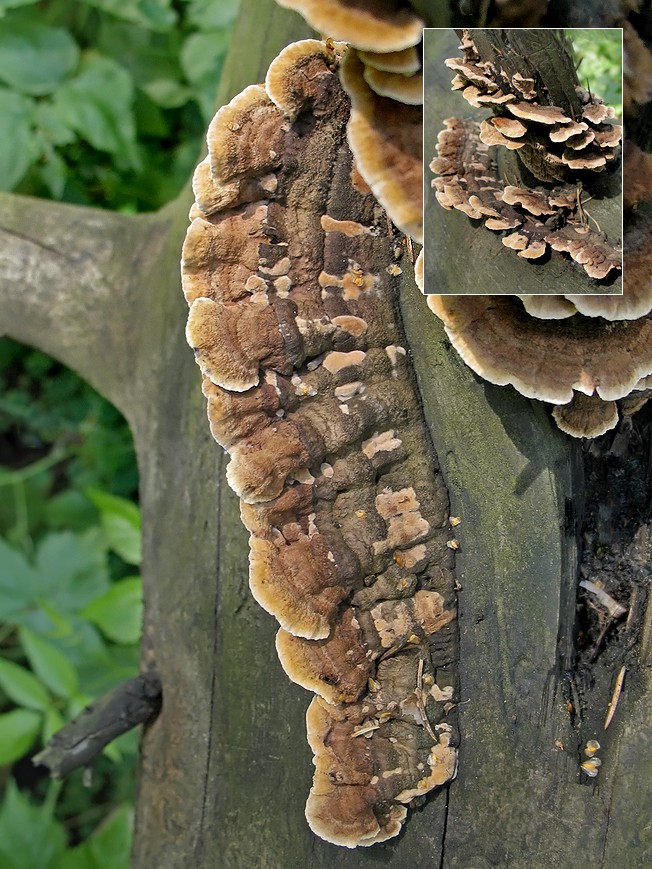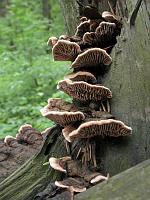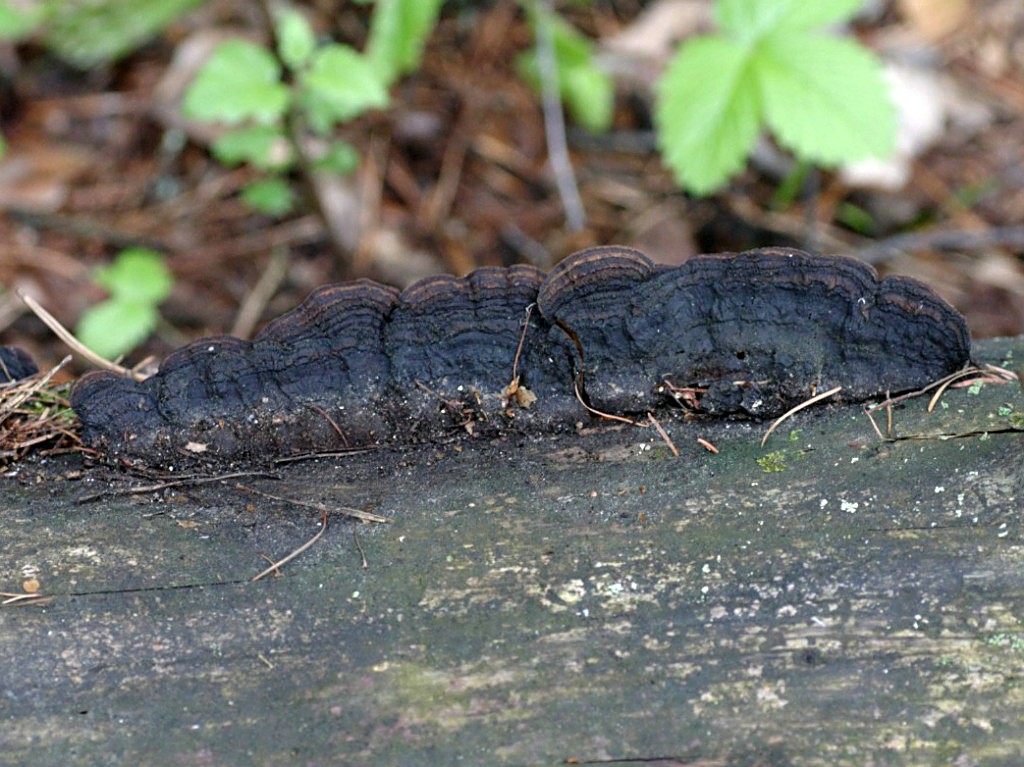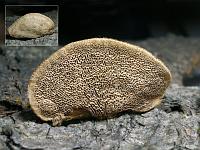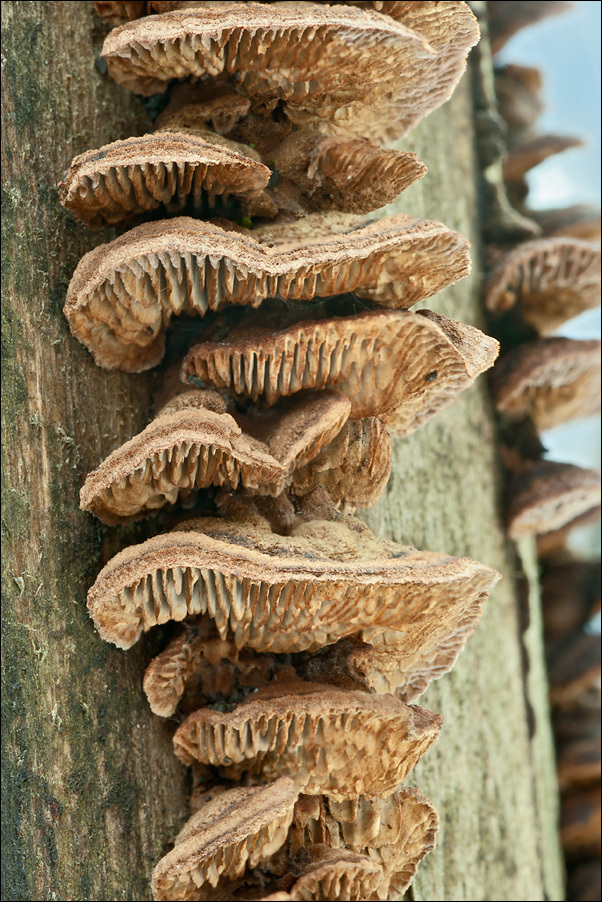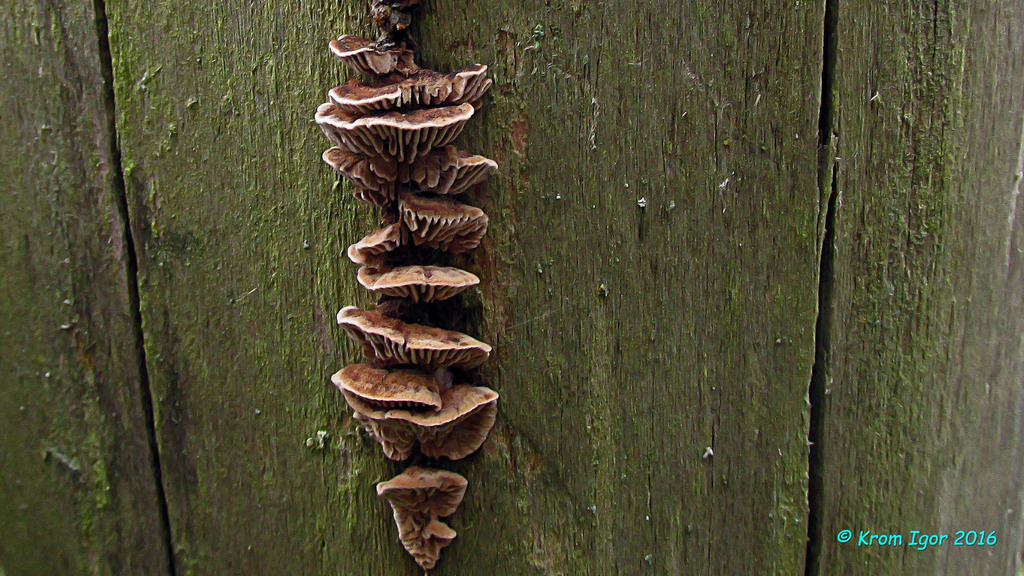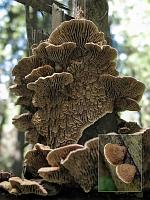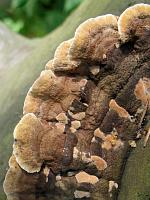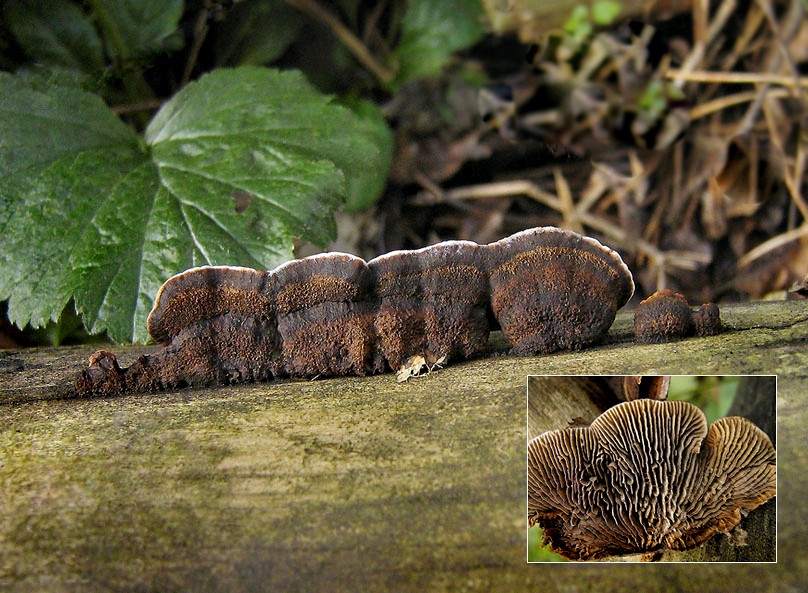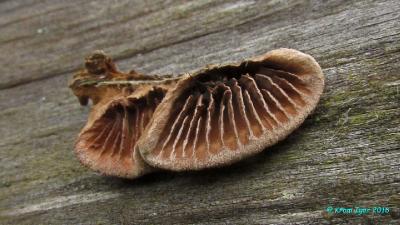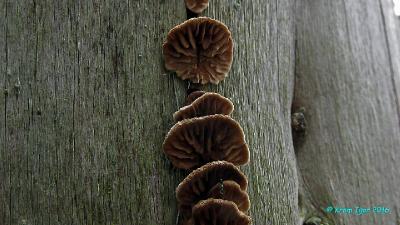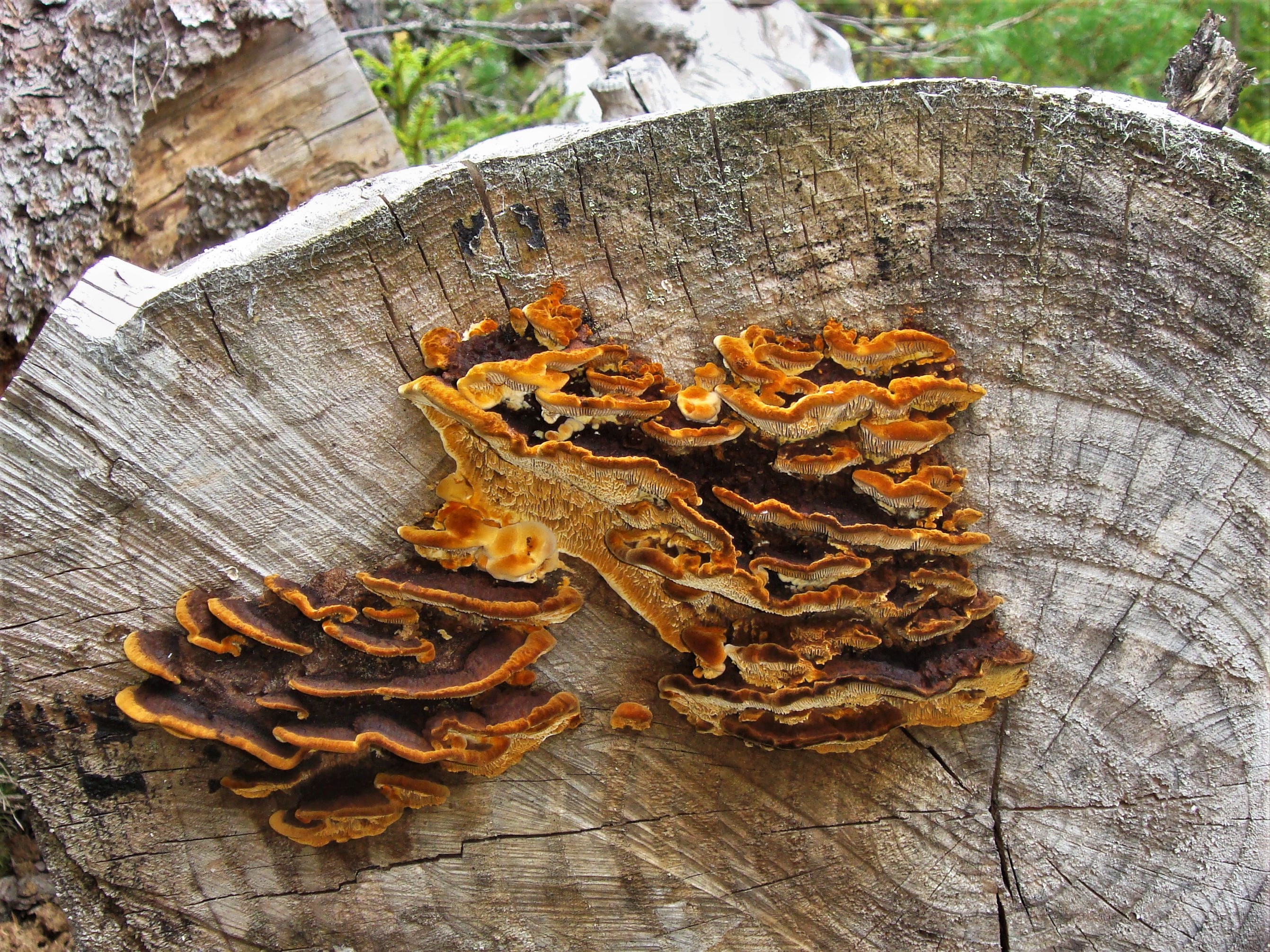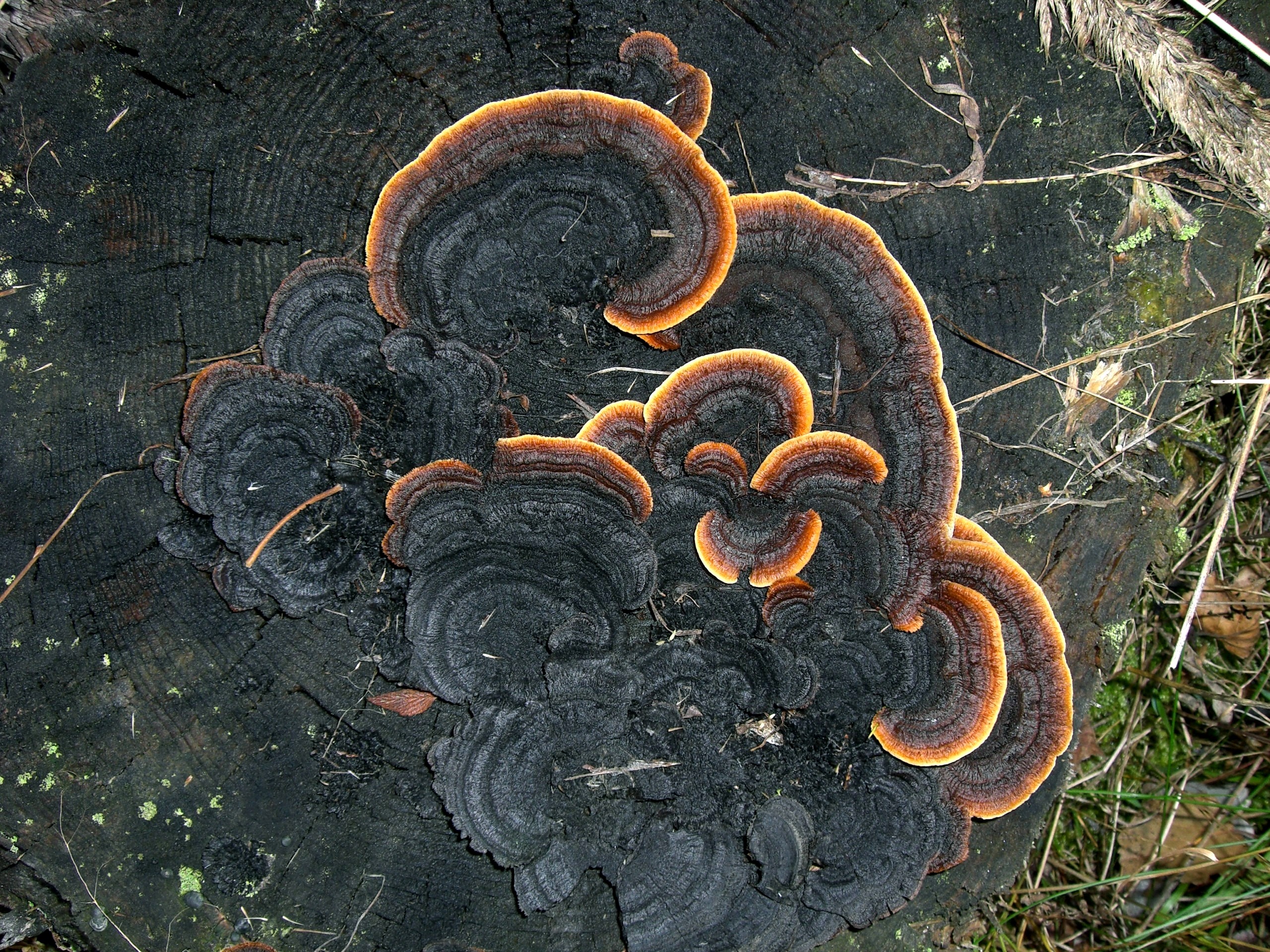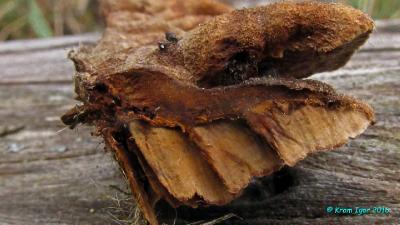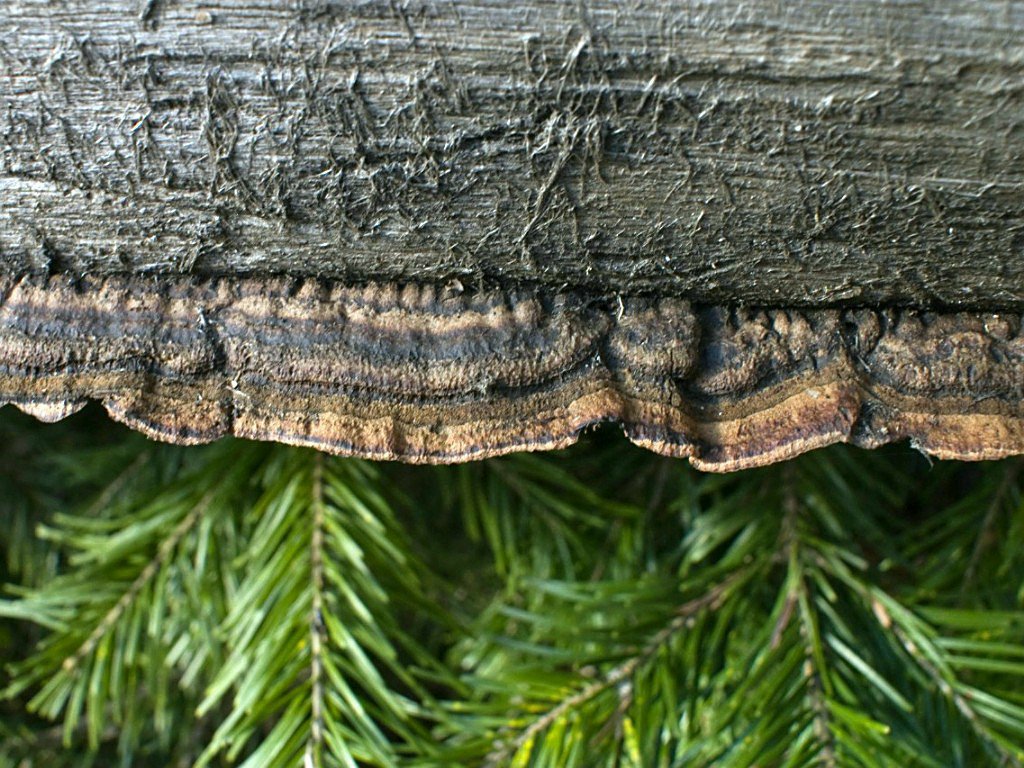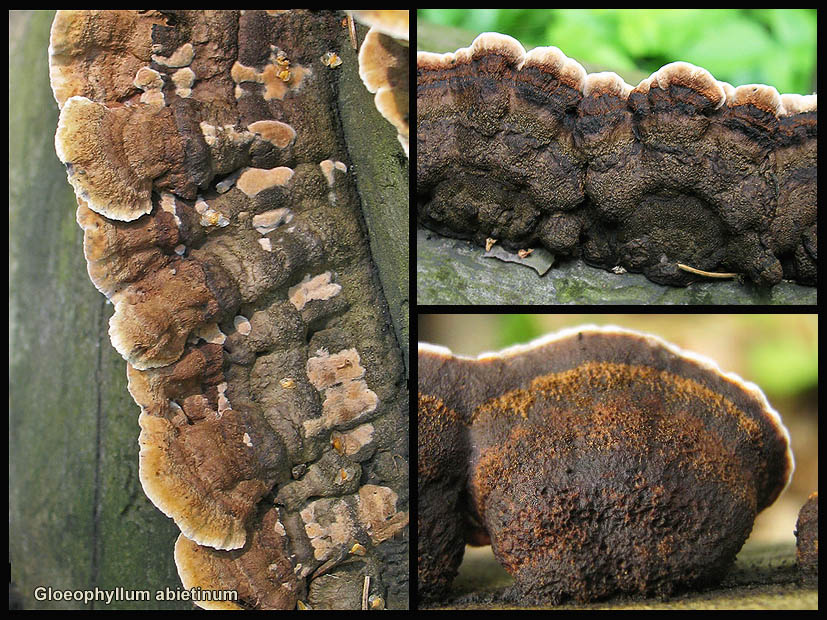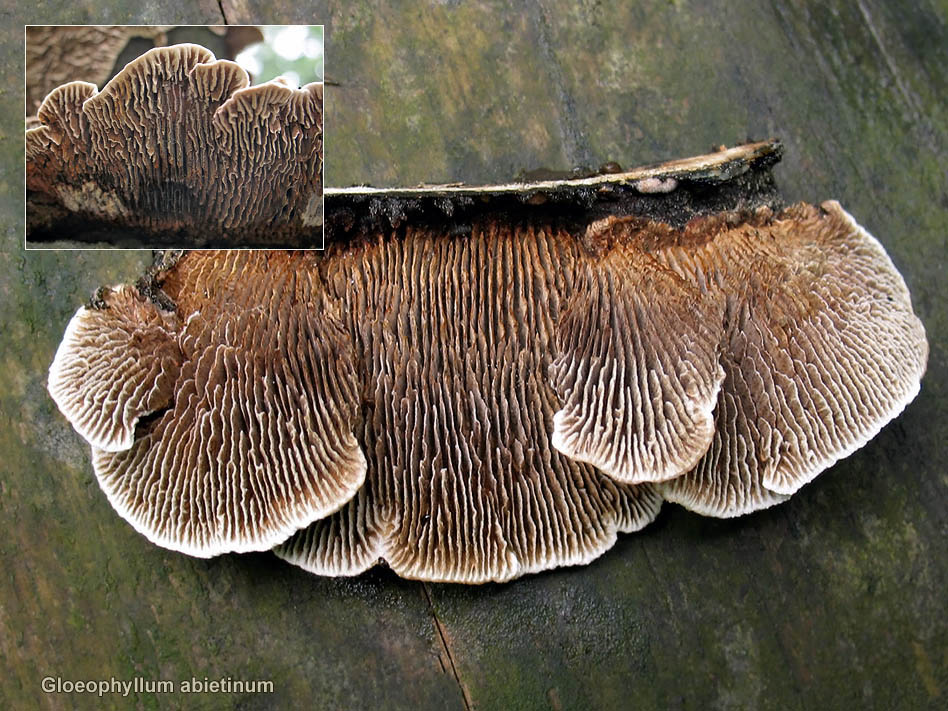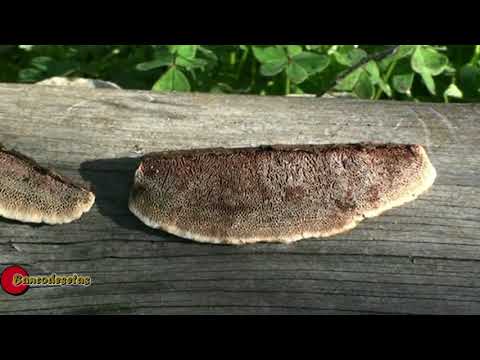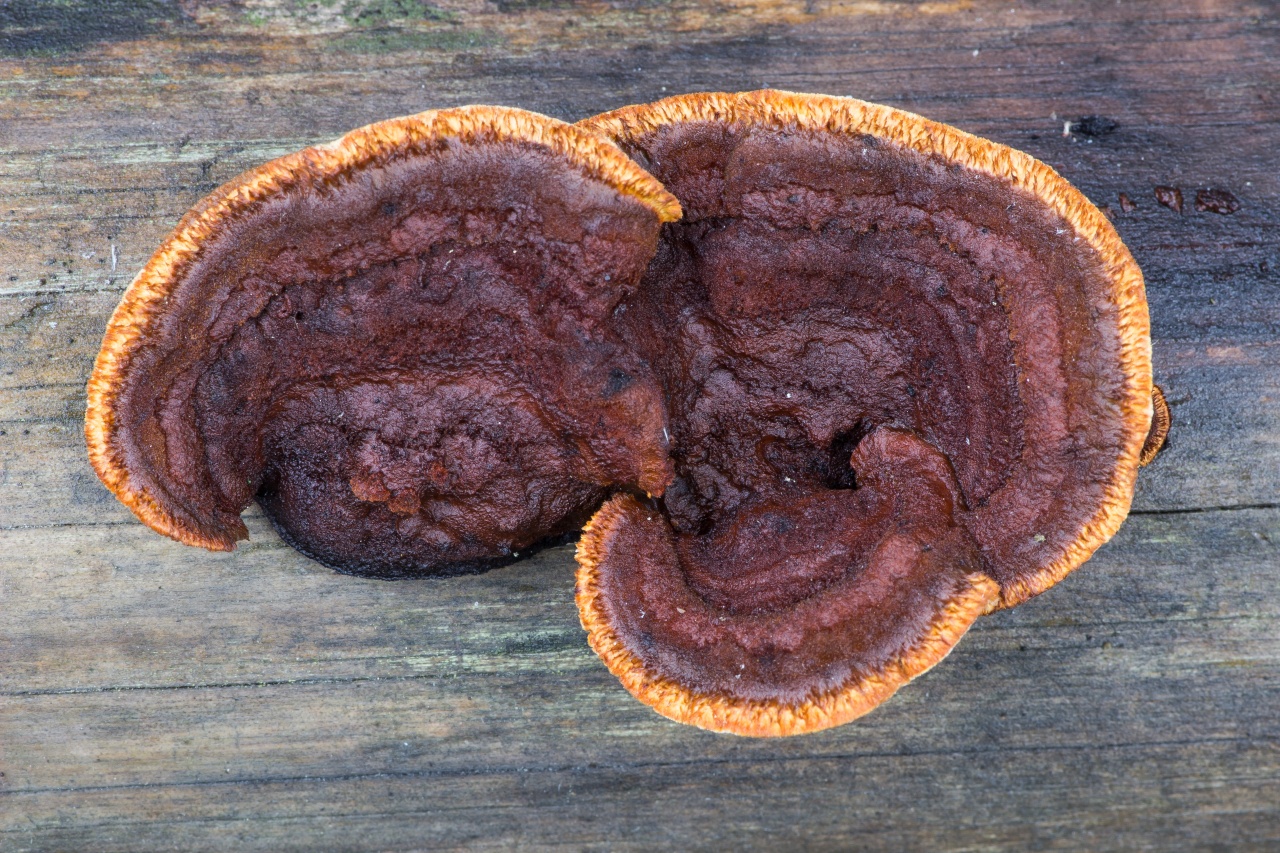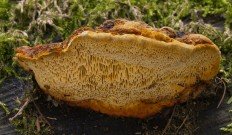Biological description
Fruiting bodies are annual to 3-4 years old, rosette, half, fan-shaped or irregular, occasionally widespread, growing together laterally, often tiled along the substrate. The upper surface is covered with bristly pubescence, uneven, lumpy-notched, with varying degrees of pronounced concentric zones. The color is bright rusty brown, then dark brown.
The hymenophore is initially represented by short-labyrinth-like tubules, then it becomes irregularly lamellar, light brown in color, darkening to rusty brown in old fungi.
The hyphalous system is trimic. Generative hyphae are thin-walled, septate, uncolored, with buckles. Skeletal hyphae are reddish-brownish, thick-walled, sometimes almost continuous. The connecting hyphae are also thick-walled and short-branched. Cystids are numerous, fusiform, uncolored, 15–35 × 4–6 µm. Basidia are tetrasporous, 20–30 × 5–6 µm. Spores are uncolored, non-amyloid, cylindrical, slightly asymmetric, 9-12.5 × 3-4.5 µm.
Gleophyllum does not contain any poisonous substances, however, its tough fruiting bodies do not allow it to be counted among edible mushrooms.
Similar species
In addition to the intake gleophyllum in Russia, two more lamellar types of gleophyllum are known - fir gleophyllum and log gleophyllum. The plates of the first of them are not clearly expressed, tubular. In the second type, the plates are more developed, but noticeably thicker than in the tinder fungus.
Taxonomy
Gleophyllum was first described by Franz Xaver von Wulfen in a combined genus of lamellar mushrooms in 1786. Since 1802, it was most often described as part of a narrower combined genus of mushrooms with a labyrinthine hymenophore. In 1882, the Finnish mycologist Peter Adolf Karsten singled it out into a separate genus Gleophyllum.
Synonyms
- Agaricus boletiformis Sowerby, 1809
- Agaricus sepiarius Wulfen, 1786basionym
- Agaricus undulatus Hoffm., 1797, nom. illeg.
- Daedalea sepiaria (Wulfen) G. Gaertn., B. Mey. & Scherb., 1802
- Daedalea sepiaria var. undulata Hoffm. ex Pers., 1828
- Daedalea ungulata Lloyd, 1915
- Gloeophyllum ungulatum (Lloyd) Imazeki, 1943
- Lenzites argentinus Speg., 1898
- Lenzites sepiarius (Wulfen) Fr., 1838
- Lenzites undulatus (Hoffm. Ex Pers.) Sacc. & Traverso, 1912
- Merulius sepiarius (Wulfen) Schrank, 1789
Feoklavulina fir (Phaeoclavulina abietina)
Synonyms:
- Fir Ramaria
- Fir horned
- Spruce horn
- Spruce ramaria
- Clavaria abietina
- Merisma abietinum
- Hydnum abietinum
- Ramaria abietina
- Clavariella abietina
- Clavaria ochraceovirens
- Clavaria virescens
- Ramaria virescens
- Ramaria ochrochlora
- Ramaria ochraceovirens var. parvispora
As is often the case with mushrooms, Phaeoclavulina abietina “walked” from one genus to another several times.
This species was first described by Christian Hendrik Persoon in 1794 as Clavaria abietina. Kele (Lucien Quélet) transferred him to the Ramaria clan in 1898.
Molecular analysis in the early 2000s showed that in fact the Ramariya genus is polyphyletic (polyphyletic in biological systematics is called a group in relation to which it is considered proven that its constituent subgroups are more closely related to other groups that are not included in this group).
In English speaking countries, the spruce horn is known as "green-staining" coral. In the Nahuatl language (Aztec group), it is called "xelhuas del veneno", which means "poisonous broom".
Description
Fruit bodies are coral. Bunches of "corals" are small, 2-5 cm in height and 1-3 cm in width, well branched. Individual branches are erect, sometimes slightly flattened. Near the very top, they are bifurcated or decorated with a kind of "tuft".
The stem is short, green to light olive. The matte whitish mycelium and rhizomorphs are clearly visible, leaving into the substrate.
Fruit body color in green-yellow tones: top from olive-ocher to dull ocher, the color is described as "old gold", "yellow ocher" or sometimes olive ("dark greenish olive", "olive lake", "brownish olive" , "Olive", "hot citrine"). On impact (pressure, break) or after collection (when stored in a sealed bag), it quickly acquires a dark blue-green color (“green bottle glass”), usually from the base gradually to the tops, but always first at the point of impact.
The pulp is dense, leathery, the same color as the surface. When dry, it is fragile.
Smell: Subtle, described as soggy earth Taste: Mild, sweetish, with a bitter aftertaste.
Spore powder: dark orange.
Season and distribution
Late summer - late autumn, depending on the region, from mid-late August to October-November.
Grows on coniferous litter, on soil. It is found quite rarely, in coniferous forests throughout the temperate zone of the Northern Hemisphere. Forms mycorrhiza with pine.
Edibility
Inedible. But some sources indicate the mushroom as "conditionally edible", of poor quality, preliminary boiling is required. Obviously, the edibility of Feoklavulina fir depends on how strong the bitter aftertaste is. Perhaps the presence of bitterness depends on the growing conditions. There is no exact data.
Similar species
Common Ramaria (Ramaria Invalii) may look similar, but its flesh does not change color when injured.
Note
The name "Spruce Horn (Ramaria abietina)" is indicated as a synonym for both Phaeoclavulina abietina and Ramaria Invalii, in this case they are homonyms, and not the same species.
Habitat and ecology
Gleophyllum is a cosmopolitan, more common in the temperate zone of the Northern Hemisphere.
Intake gleophyllum is a saprotroph that grows on stumps, dry and fallen trees of conifers, usually in open places and forest glades. It rarely affects deciduous species (eg aspen). Causes brown rot, quickly penetrating into the substrate.
In confined spaces, where the fungus periodically appears, fruiting bodies are most often underdeveloped, sterile, coral-branched. The hymenophore in such fungi can be completely reduced or present in the form of irregular tubules without spores.

